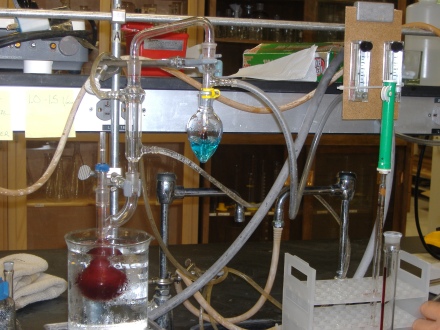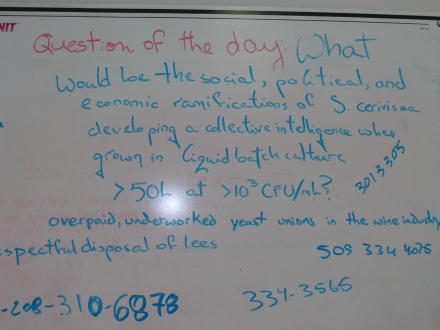The Australian Wine Research Institute (AWRI) has launched a new winery service. Winemakers can now submit samples from natural/wild/native/non-inoculated ferments (or, conceivably, from an inoculated one if they wanted to) and, courtesy of “next-generation DNA sequencing*,” receive a profile of the yeast species present along with approximate percentages. An additional step can give them more specific strain information, and the AWRI can also isolate, freeze down, and store the main yeasts from your sample as “insurance” if you need them in future vintages.
This sounds like marvelous geekery. Winemakers who don’t inoculate probably wonder about what’s going on in there at least occasionally. What I’m unsure of is whether this yeast profile is a useful management tool beyond a fun way to satisfy your curiosity (or give even more detailed information to very well-heeled consumers). I imagine the following scenarios:
Good natural ferment — You like what’s happening with your uninoculated wine. You’re going to keep making it even if you learn that some generally undesirable bug has part of the action because you know you like the results. Maybe having a yeast profile sets you a benchmark so that if the ferment stops working in some future vintage you can send in a sample for comparison and see if the microbial blend changed, but how does that information then change what you do?
Bad natural ferment – You’ve tried not inoculating a wine and it isn’t working for you for whatever reason. You send in a sample from one that didn’t work (too slow, undesirable flavors, or didn’t finish fermentation). Maybe you’ll learn that some toxic bug is out-competing the yeasts you need to grow, or you’ll identify the source of that high volatile acidity you’ve been combatting. What then? The natural ferment still doesn’t work. Can you tweak pH or how much sulfur dioxide you use or your oxygen management to encourage more favorable microbes against the enemy? I don’t know how likely someone is to successfully adjust or amend a natural ferment to work better at that level — from the perspective of philosophy as well as how likely it is to work — but if you’re going to try these strategies, you’ll likely know to try them without knowing which yeast species are involved.
Planning a natural ferment – Maybe you run a test natural ferment to see whether you like what it does, and you want to “double-check” that it’s okay. The primary information you need stays the same: does it ferment to dryness? does it move fast enough to satisfy your economic needs and peace of mind? does it taste good? These will remain the primary drivers of your decision to move ahead or not, independent of what you learn from that yeast profile.
This service can help answer that perennial question of whether the yeasts in your “wild” ferment are really wild or just commercial yeast strains that have colonized your winery, and to some extent (especially if you go down to that extra strain level sequencing) the degree to which your ferment is different from some other winery’s. But the question — the AU $275 question for running a single sample, or AU $792 for the recommended panel of three samples per ferment — is this: will the extra information change what you do?
Nevertheless, forward-thinking actionability isn’t everything. Even if a winery never tries to replicate a previous successful wine by inoculating with its bespoke mix of strains banked through the system (that seems unlikely to succeed simply given the enormous variability in other parameters affecting wine quality directly and indirectly via influencing yeast growth), a retrospective look at yeast mixes in multiple vintages of the same natural ferment could be interesting. Did a change in viticultural management practices, or source of grapes, or fermenting conditions correlate with a clear change in microbial populations? That prospect makes me hope for two things. First, that a winery (or a dozen or two) will use this as a tool for looking back at the path they’ve taken and not just down at where they’re standing. Second, that when they do, they’ll share.
*Next-generation DNA sequencing (this introduction from Nature is dated and technical, but it’s also open-access; the article on Wikipedia is also quite good) is a collection of methods so called because they rely on new strategies for sequencing DNA — not just tweaks of the old traditional way, but really new ways of solving the problem — that let us do things differently, faster, and more efficiently. The most important things to know about next-generation sequencing are that, 1) it’s not a method, but a general term for a whole bunch of methods; 2) the idea has been around since 2008, which doesn’t mean that any of those methods can’t be cutting edge but which does mean that they’ve “trickled down” to the general market by now; and 3) they allow for pulling many sequences from many different organisms out of a single small sample. Old sequencing methods required a relatively large sample of (preferably) a single pure target sequence or else the signals would get so jumbled up that the whole instrument read-out would just look like soup (as I recall well from my first sequencing experiments as an undergrad in 2002-3). Now, we can sequence even single stretches of DNA, and even many different single stretches all hanging out in the same sample from some real-life microbe-rich setting: soil, seawater, or an active ferment. And we can do it quickly and inexpensively enough, now, to offer it as a commercial service. Remember those predictions about what genomics would bring us back around 2000, when sequencing genomes really hit the news? We’re getting there.





